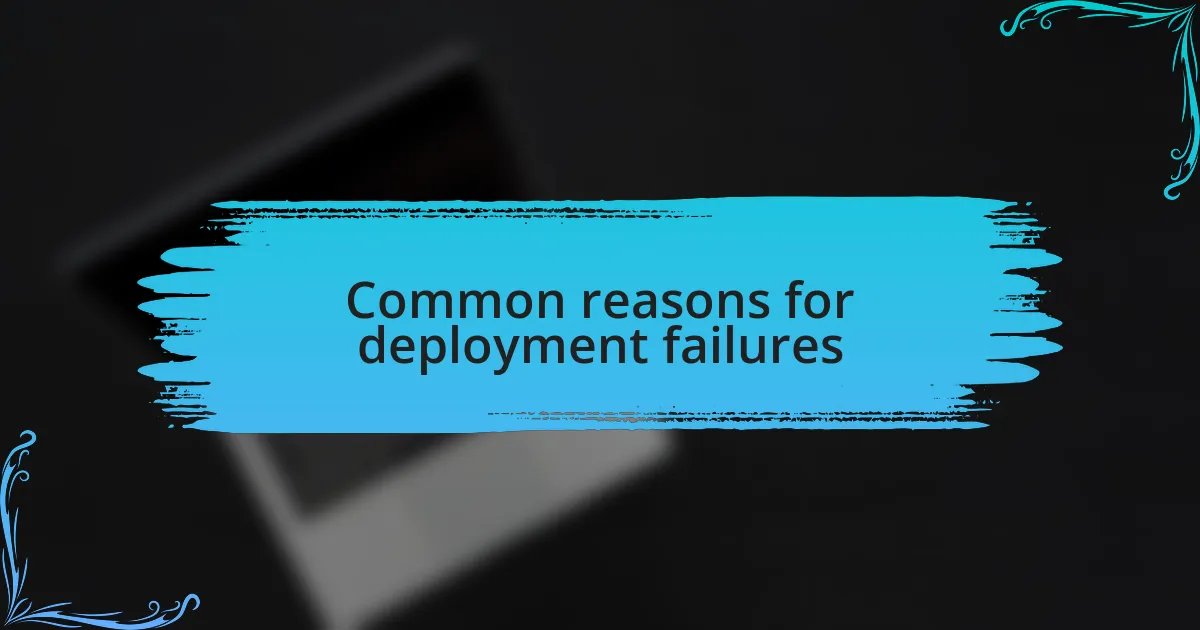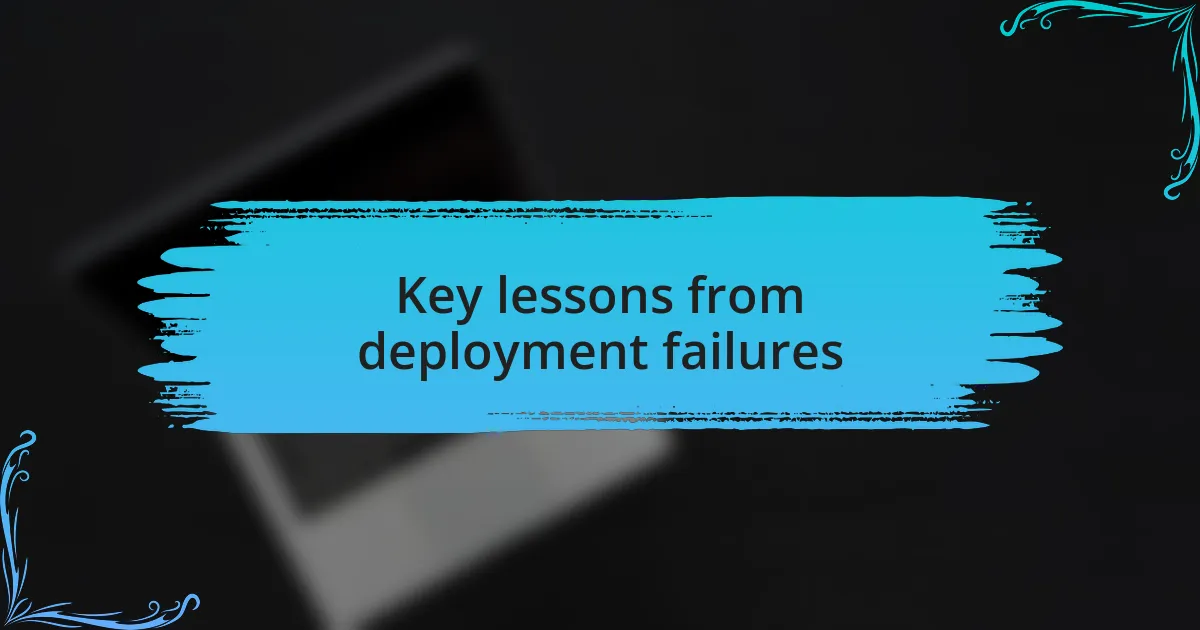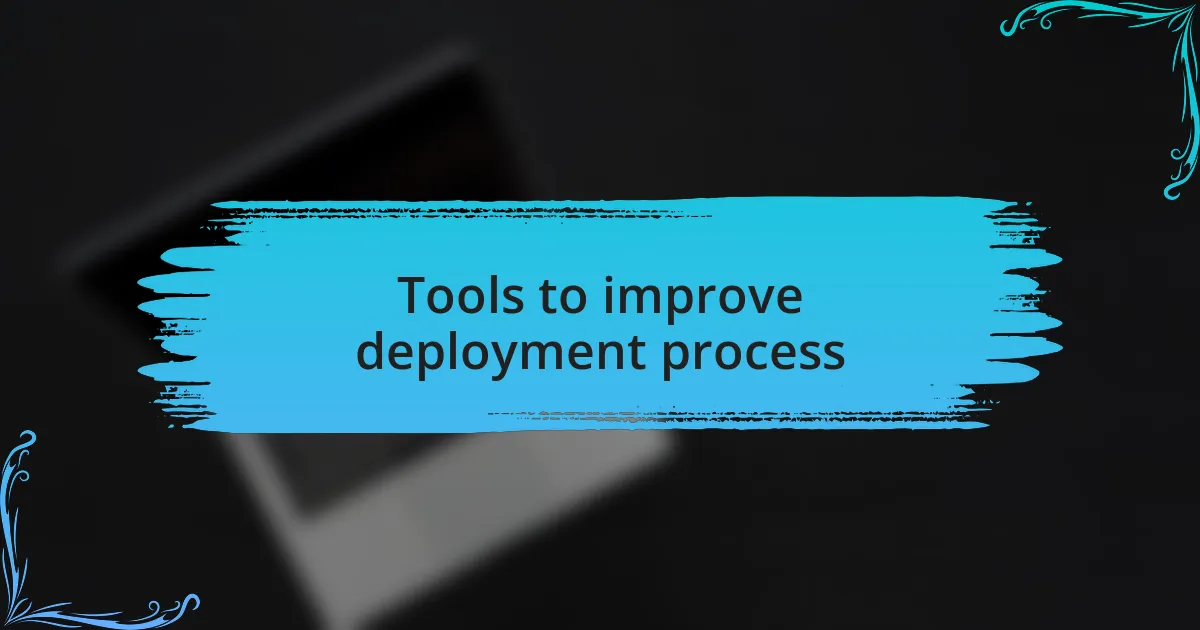Key takeaways:
- Choosing the right app development tools and engaging with community support can enhance the development experience and streamline workflows.
- Effective communication and thorough testing are crucial in preventing deployment failures, minimizing the risk of bugs and miscommunication.
- Maintaining proper documentation and adopting incremental deployments helps in troubleshooting and managing updates efficiently.
- Utilizing CI/CD platforms and monitoring tools can significantly improve the deployment process and provide real-time insights to prevent issues.

Understanding app development tools
App development tools play a pivotal role in turning ideas into functional applications. I remember the first time I dabbled in an integrated development environment (IDE)—it felt like stepping into a world where my imagination could take form. Have you ever experienced that rush of excitement when your code compiles without errors? It’s one of those moments that reminds you just how essential the right tools are in the development process.
However, understanding which tools to use can be overwhelming. I’ve often found myself asking, “Is this tool really necessary for my project?” In my experience, selecting tools that match your workflow can streamline processes significantly. For instance, using version control systems not only enhances collaboration but also safeguards against those gut-wrenching moments of losing weeks of work due to a simple mistake.
As I dug deeper into exploring various app development tools, I realized the importance of community and support. I recall joining forums and discussions, where fellow developers shared both their successes and failures. Those conversations helped me appreciate the nuances of each tool and how they could either make or break the development experience. What about you—have you found a community that enriches your understanding as you navigate through the different tools available?

Common reasons for deployment failures
Deployment failures can often stem from a lack of communication among team members. I recall a project where we rushed to push our last-minute changes without properly syncing up with the QA team. It turned out that crucial bugs slipped through the cracks, leading to a rollback that cost us time and, frankly, a bit of our confidence. Have you ever been caught in a situation where miscommunication derailed your deployment plans?
Another common pitfall is insufficient testing before deployment. In my early days, I remember being so eager to showcase my work that I overlooked comprehensive testing in different environments. This led to unexpected crashes when users accessed the app under real conditions. Sometimes, I ask myself, “What if I had just taken a little more time to ensure everything was solid?” The benefits of thorough testing cannot be overstated.
Finally, relying on outdated or incompatible technologies can also spell disaster. I learned this the hard way during a deployment when I discovered the new API we integrated was incompatible with the current framework. The frustration was palpable as we scrambled to find a workaround, which made me appreciate the importance of keeping our tech stack updated. Have you ever faced a similar challenge that made you rethink your technology choices?

Key lessons from deployment failures
When reflecting on deployment failures, I’ve found that one key lesson is the importance of proper documentation. I vividly remember a scenario where a teammate had made significant changes without adequate notes or comments. It was like piecing together a puzzle without having the full picture. This experience taught me that well-maintained documentation not only aids in understanding the current codebase but also serves as a crucial resource when troubleshooting issues post-deployment. Have you ever wished you had an instruction manual for an unexpected problem?
Another significant insight revolves around the value of incremental deployments. Early in my career, we opted for a massive update that combined numerous features and changes. The excitement was palpable, but when things went wrong, it became challenging to pinpoint the exact issue. I’ve since adopted a more cautious approach, deploying updates in smaller, manageable increments. This practice allows for easier tracking of errors and a quicker comeback if something doesn’t go as planned. Doesn’t it feel more secure to tackle one change at a time rather than diving into a complex overhaul?
Lastly, I’ve learned that engaging in post-mortem analysis after a failed deployment can be invaluable. After one particularly rough week of scrambles and late-night fixes, we gathered as a team to discuss what went wrong. Sharing our insights created a sense of camaraderie and encouraged open dialogue about the mistakes we made. This experience reinforced the idea that learning from failure isn’t just about fixing errors; it’s also about fostering a culture of growth and transparency. Have you taken the time to reflect on your mistakes to fuel your future successes?

Best practices for successful deployments
One of the best practices I’ve adopted for successful deployments is thorough testing, both automated and manual. There was a time when we relied solely on automated tests, assuming they covered every possible scenario. But after missing a critical bug that surfaced during manual testing, I realized the importance of having both approaches in place. Doesn’t it make sense to double-check our work before launching it into the wild?
Communicating effectively with the entire team is another crucial aspect of a smooth deployment process. I recall an instance where a simple miscommunication led to a last-minute change that disrupted our timeline. It caught me off guard and increased everyone’s stress levels. Since then, I’ve made it a point to establish open channels for dialogue and ensure everyone is on the same page before any launch. Have you ever felt the tension that comes from unclear expectations?
Finally, having a rollback plan is essential. I learned this the hard way when a deployment introduced unforeseen issues, and we were left scrambling without a clear path back to stability. Nowadays, I always prepare a strategy for reverting changes if necessary. Having that safety net gives me peace of mind and confidence when pushing new features. Isn’t it comforting to know that there’s a way back if things don’t go as planned?

Tools to improve deployment process
One tool that significantly improved my deployment process is Continuous Integration/Continuous Deployment (CI/CD) platforms like Jenkins or CircleCI. I remember the frustration of manually deploying builds, which often led to human error and inconsistent results. Automating this process not only streamlined my workflow but also reduced the overall deployment time. Would you believe how much peace of mind it brings to automate what once felt like a chaotic race against the clock?
Another tool that has proven invaluable is version control systems, particularly Git. I once faced a situation where deployments were sabotaged by minor inconsistencies in the codebase. Utilizing Git allowed me to manage changes more effectively, enabling quick rollbacks and seamless collaboration among my team. It’s fascinating how something as fundamental as version control can dramatically enhance stability. Have you ever given thought to how much easier it could be to trace back your steps in code?
Lastly, I can’t emphasize enough the importance of monitoring tools like New Relic or Datadog. In one deployment, we overlooked performance metrics, and it resulted in application downtime that rattled our user base. By integrating monitoring tools, I gained the ability to track real-time performance and receive alerts on potential issues before they escalated. It’s empowering to have those insights right at my fingertips—don’t you think being informed instantly can prevent a lot of headaches?

Personal reflections on deployment challenges
Facing deployment challenges has truly been a rollercoaster for me. I recall one particular incident where, after a long night of coding, we implemented a significant update only to realize we had missed a critical dependency. The frustration was palpable, especially knowing that a simple oversight could lead to hours of downtime. Have you ever felt that sinking feeling in your stomach when everything seems to unravel?
I also learned that communication within the team is essential during deployments. There was a time when a lack of clear channels led to overlapping changes being pushed simultaneously, creating chaos. I’ll never forget the urgency in our voices as we scrambled to resolve the conflicts. It’s amazing how a few minutes spent discussing precisely what everyone is working on can save you from untangling a huge mess later. Have you ever experienced the relief that comes from a well-coordinated team?
Another lesson that stands out is the value of thorough testing before deployment. I vividly remember a scenario where we rushed a release, convinced that it was flawless. Unfortunately, we quickly discovered a critical bug that impacted our users significantly. That experience taught me the hard way that patience in the testing phase pays off immensely. Don’t you agree that taking the extra time for testing can ultimately lead to smoother deployments and happier users?